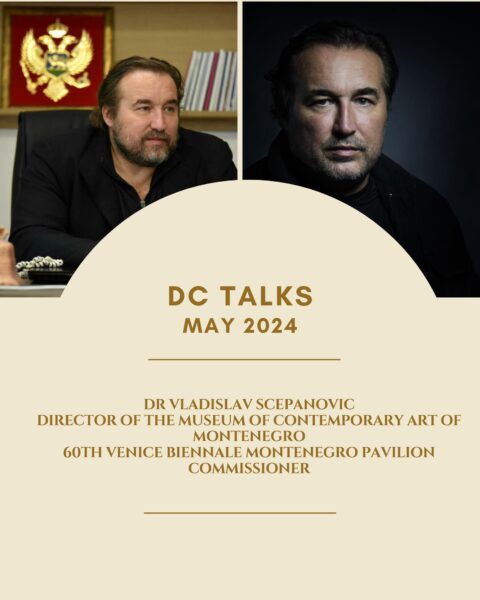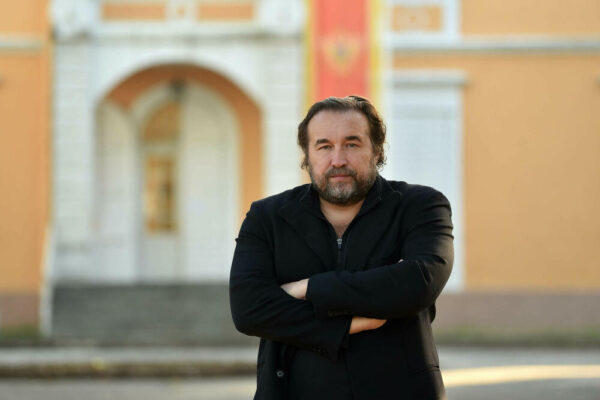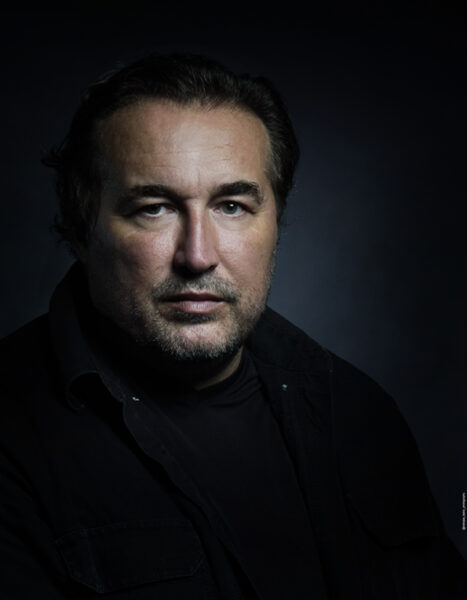
As part of DC Talks, DC Slovenia interviewed recently Dr Vladislav Scepanovic after a successful presentation of Montenegro at the 60th Venice Biennale.
- You opened the Montenegrin pavilion with a large number of guests and people who sincerely support your work. What is it like to be the commissioner of one of the most respected and oldest events in the field of contemporary art?
Being a commissioner for an event like this is a great privilege, as well as a great responsibility. First and foremost, I tried to present the Montenegrin exhibition in Venice in the best possible way. We found a new space that is far more visible than the space where we previously exhibited, and I tried to ensure that the exhibition and the opening ceremony were at a high-level.
- The main theme of this year’s Biennale is Foreigners Everywhere – Stranieri Ovunque. Why do you think it was decided that this is the main theme and inspiration for artists?
The instability of the time in which we live, fast communication flows and large waves of migration have made this issue relevant and topical. The theme is deeply complex, and it can be analyzed from different perspectives, including that of internal instability, both in terms of personal identity and that of the community or nation. The sense of duration, permanence and certainty is deeply disturbed, so that apart from migration caused by wars and economic disbalance, we sometimes become foreigners within ourselves, our family, nation and state. That frustration becomes fertile ground for artistic creation, which is also pronounced in this biennale.
- In addition to being the director of the Museum of Contemporary Art and the Commissioner of Montenegro, you are also an artist, painter and a professor. How do you, as an artist, look at the selected theme?
This is an inspiring topic for artistic engagement. Art is often triggered by frustration, inhibition, revolt or deep impressions, and the position of a foreigner can embody all of those conditions, thus leading to a wide range of possibilities for artistic expression. Had I participated in this biennale as an artist, I would have been deeply inspired by the theme.
- Is it difficult to decide which work will represent the country at the Biennale and why? In your speech at the Biennale, you mentioned that you have new selection procedures.
I have rich experience in organizing exhibitions for the Venice Biennale, which developed my understanding of the pros and cons of the various methods of choosing representatives for this event. I wanted to democratise the process and provide opportunity to different artists and curators to participate in the competition. Here, above all, I am referring to the form of artistic expression, but also generational determination. Therefore, we focused exclusively on the quality of artistic production, and the decision was made by an international jury that was not conditioned by anything other than the quality of the work. In such a free and democratic atmosphere, we made the decision that the project implemented by the artist Darja Bajagić, curated by Ana Simona Zelenović should represent Montenegro at this biennale.

- The name of the chosen exhibition is “It takes an Island to feel This Good”. Why is it called so and what is your opinion about this title?
This title, in my opinion, is ambiguous because it alludes to the symbiotic relationship between the history of this island and its current status as a luxury tourist resort. Should something that was a prison camp, a place of human suffering, and a fortress built by occupiers, by some perverse twist of fate, become a place of enjoyment just because of its location? Or does the perversion take the form of capitalism, which relishes in the knowledge that the island was a place of torture, as nothing less would satisfy its hunger. Whatever the case, cultural and historical heritage is finding it increasingly difficult to resist the pressure of conformism and the failing nature of everyday reality.
- Beside Montenegrin pavilion, of course, which other works would you highlight as important for visitors of Bienale?
There are plenty of high-quality pavilions, among which I would single out the Australian, Japanese, Serbian, Croatian, French, Korean… As for the central pavilion, it follows a strict conceptual criterion, which, in my view of art, limits the quality of artistic representation. Sometimes the central idea can create boundaries which harm the quality of the work, but such an approach is undoubtedly legitimate. The central theme could be successfully tackled by artists from less developed countries as well, because it is of general, rather than marginal interest.
- The Montenegrin Minister of Culture announced that there is a great chance that Montenegro will get a place at the Arsenale at the next Biennale. Can you tell DC Slovenia readers more about that?
In an effort to stir things up in Montenegro in terms of our approach to contemporary art, we should make our presence more visible. As I mentioned before, we have already made progress compared to the previous exhibition, but our ambitions for the future include presenting Montenegro in an even more vibrant area of the biennale. Arsenale is our goal for next year and I hope we will achieve it.

- Is it true that all the curators of your museum were at the Biennale and why did you make such a decision?
My curators are the curators of the Museum of Contemporary Art, and therefore I think they should visit as many high-profile artistic events as possible. As the Venice Biennale is the largest exhibition in the area of contemporary art, it is quite logical that my curators should be present at such an event. I will try to travel as much as possible in the future and work with likeminded colleagues in order to expand our network our institutional programe. In my view, educating museum staff is one of the critical building blocks for a quality institution.
- Why is it important for art to remain independent of political and other influences and do you encounter this in your work?
I think it is not only important, but prerequisite for art to exist. Even in ideological regimes where such an approach would not seem possible at first glance, there are examples of subversive artistic energy that testify to freedom being the primary principle of art. Furthermore, I would argue that art is the last form of free expression in society, which means that it is increasingly important. In my artistic work, I often encountered censorship, which was a reliable indicator that I was on the right path. If the doxa is disturbed, then art, as a form of paradox, is a response to the intoxicated society of the digital spectacle in which we live.
- Your “arrival” at the Museum has made great changes. Do you manage to realize all the plans and which ones are the most important for this year? We know that a new building is being built, what about the competition? Which world exhibitions do you bring to Podgorica and how do you manage this, given that the museum doesn’t even have a building?
I try to feed my rich experience as an artist, theoretician, professor and manager into the institution that I lead. As I am rebuilding the very foundations of the institutions, I am faced with significant challenges, which I am taking on with my full capacities. The other day, we received a conceptual model for the new museum building, which I am very satisfied with. The first place in the competition was won by the Italian architectural bureau, A-FACT. We currently work in the Petrović Palace, and have already hosted important names in that space. Currently, we are hosting an exhibition of the Icelandic artist Erro, and soon we will have Kiki Smith, Sam Durant, Šejla Kamerić, Laibach, Yoko Ono and many others.
- On the Venice Biennale you are a commissioner, but you were also an artist, a curator. Which of the mentioned roles fits best for you personally?
For me personally, the best position is that of the artist because it allows one to focus exclusively on presentation of the artwork. The role of commissioner entails responsibility for the entire process, from designing the concept of the exhibition, organizing the competition, searching for an adequate exhibition space, to handling administrative requirements that are often not very inspiring. And yet, doing something good for my country gives me an immense feeling of personal satisfaction.